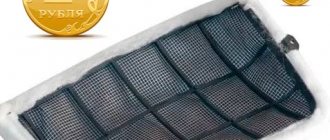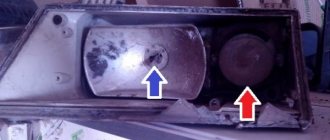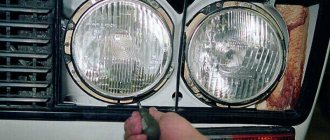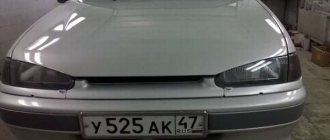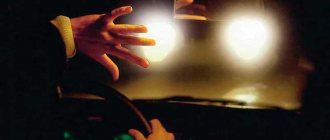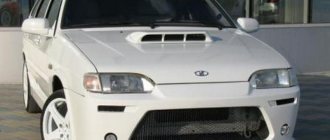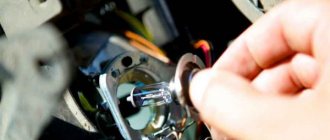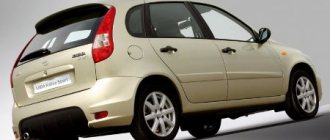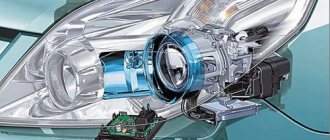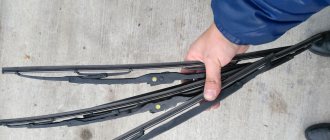If you decide to modernize and tune your VAZ brake lights or taillights on your own, it will be useful for you to familiarize yourself with some ideas. Options for tuning headlights on a VAZ 2114 are given below.
Manufacturing of overlays
In order for the front or rear lights on a VAZ 2114 to be equipped with overlays, you need to perform the following steps:
- First of all, the rear lights of the VAZ 2114 must be covered with masking tape, and then the tape should be applied to a special fiberglass cloth.
- The diode pads will be mounted into this fabric, so it also needs to be impregnated with epoxy glue. The glue itself is applied in two or three layers. To make VAZ signals look better, you should get rid of all irregularities on the surface, and then wait until the glue has completely dried.
- After complete drying, the workpiece is dismantled. If you are making overlays for the rear lights, then you need to use a marker to mark the contours of the elements, and you need to take into account that the overlays do not interfere with the headlights burning normally. Once the outline is marked, the shapes themselves need to be cut out using scissors, and then they will need to be puttied. When the surface is dry, it will need to be treated with fine-grained sandpaper, after which primer is applied to the pads, and after it has dried, a base coat of paint is applied.
- When the paint has dried, varnish should also be applied to the surface. After this, the covers for the rear lights can be installed in the optics.
Angel eyes of the domestic VAZ
Installing LEDs in taillights
Another tuning option is to install LED lights in the optics.
The scheme of work is as follows:
- First, the headlight is removed from its installation location. After this, you need to cut it into two parts - separate the glass from the main structure, you can try cutting the seam with a knife.
- After this, you will be able to access the reflectors, as well as the reflective elements - these also need to be dismantled. Next, in accordance with the diagram, the headlights are completely disassembled, and the place where the diode lights will be located is marked on them with a felt-tip pen or marker.
- Circles of self-adhesive film should be glued inside the structure. The diameter of these circles should be 1.5 cm.
- After these steps, the surface of the dimensions, as well as the brake lights, must be treated with silver red. After it has completely dried, the previously applied film is dismantled.
- Installation of reflective elements is carried out on a small layer of glue. For prevention, all joints of the structure can be treated with sealant. The diode boards themselves must be installed in the optics housing and securely fixed. After this, a stabilization circuit is installed, the purpose of which is to regulate the diode connections. Having completed these steps, the rotating blocks can be connected back to the main optics, and the modules themselves should be installed with epoxy glue.
- At the final stage, it is necessary to check the functionality of the flashlights - if everything works in normal mode, then you can assemble the optics in the reverse order. Securely glue the glass of the lantern to the main block - if the fastening is unreliable, this can lead to fogging of the glass (video author - Alexander Amochkin Kolomna AAK channel).
Manufacturing of diode rings
The procedure for making diode rings is as follows:
- The rings themselves must be placed in special cylinders; they must be made with your own hands in advance; for these purposes it is quite possible to use tin cans, for example, from canned food. These cans are carefully cut so that you end up with a well-like structure. In total, you should have two wells - external and internal. After this, the wells themselves can be painted.
- After this, conventional reflectors must be installed in the internal elements to reflect light. If you install diode rings in the rear lights, then the reflectors should be white, if in the dimensions, then yellow, if in the fog lights, then red. The remaining space that remains after installing the reflectors must be equipped with a diode ring.
- The next stage is the installation of reflective elements and diode rings. In order for these components to be securely fixed, it is necessary to equip the structure with stiffeners in advance. Epoxyline can also be used for these purposes. The structure is installed in the optics, after which the functionality of the optics is checked (the author of the video is the LexA channel! ).
Tinting
As for tinting, the choice of this option must be approached responsibly. If a tint film is chosen that is too dark, this will result in lower visibility of the car on the road.
Accordingly, this may affect the safety of the driver and passengers:
- The optics are removed from the car, thoroughly washed, wiped and dried. If there are chips or irregularities on the headlight glass, they must be sanded using sandpaper.
- The corresponding piece of tint film is cut and glued to a flat surface.
- When applying the sticker, do not allow bubbles to form on the glass; you can use a hair dryer to smooth the film.
- After this, the excess pieces are cut off and the headlight is put in place.
Tuning optics VAZ 2113, 2114, 2115
Tuning optics is not difficult, even if you are relatively new to this matter. The main thing here is to first decide which option for modifying the rear headlights you want to use for your VAZ 2114. Today, several basic ideas are especially popular.
| Tuning type | Peculiarities |
| LED overlays | A popular and affordable option. There are many ready-made overlays offered on the market, but you can also make them yourself. To create the overlay you will need fiberglass, LEDs and epoxy glue |
| Diode rings | This modification option involves a complete replacement of the rear optics with diode rings. To manufacture them, you will need serious experience in working with electronic devices. |
| Powerful lamps | This type of modification also involves the use of a tint film for headlights. Due to the tone, bright light will be better focused. But powerful lamps have disadvantages - they increase fuel consumption, load the generator and overheat the wiring. Since the engine power of the VAZ 2114 is not high, it is not entirely reasonable to use this option |
| Individual LED elements | The most original modification option, since it allows you to express your own imagination as much as possible. But you will have to spend time and effort creating a pattern of diodes and installing them |
From a cost-saving point of view, purchasing individual LEDs will be more profitable than purchasing finished products. But in this case, you must be sure that you will be able to get high quality devices. Otherwise, it’s better not to take risks and spend more money.
• LED overlays
. Today, LED overlays are the most common option for tuning taillights with your own hands. At the same time, the vast majority of VAZ 2114 car owners prefer hand-made LED trims. There is a good reason for this - factory-made trims are not visually presentable and, for the most part, are not suitable for the lights of this car. Making LED overlays manually is not so difficult - just stock up on epoxy glue and fiberglass;
• diode rings
. Since any tuning implies the ability to work with electrical devices, making diode rings should not cause problems even for a novice auto mechanic;
• use of high power lamps
.
In most cases, this method is used before treating the glass with tint film, because the pure light of this type of lighting is too bright and can blind other road users. The effectiveness that such lamps create is offset by excessive fuel consumption and the prospect of overheating of the wiring. It is better not to use such tuning in relation to the VAZ 2114 car, since the power reserve of this car is below average; •
DIY
installation of individual LEDs This method is the most creative; it opens up a wide field for imagination. Among the disadvantages is the extra time spent, which will inevitably entail developing a design and installing the LEDs themselves on the lights. One of the advantages is the reduced cost of separately purchased LEDs.
Repair of VAZ-2114 headlights
Domestic VAZ cars are in particular demand among Russian consumers.
This choice is explained by their relatively low cost and ease of operation. But sooner or later there comes a time when the car in general and the headlights on the VAZ 2114 in particular require some repairs. In this situation, there are two options: either visit a service where everything will be done for you at your own expense, or you can easily do all the steps yourself. For example, how to change this lighting fixture on the presented model with your own hands? At first glance, it seems that this is very difficult and impossible to cope with on your own. But in reality it's not like that.
First you need to choose the place where you will perform this operation. It is better if it is a flat space. When carrying out the procedure, the car must be parked with the parking brake on.
Important step
Why is replacing optics in a car an important and responsible process? Because for the slightest violation (if, for example, the headlights are too dark), a fairly decent fine is provided.
That is why before starting work, it is worth carefully studying the depth of darkness. That is, if the car owner has a luxurious white car, then black optics will not always be in place.
And indeed, if you look closely at a variety of photos of headlight tuning made by yourself, you will notice that they do not go into too black shades and tones.
The best option (for any make of car) is to use a dark shade on some small area of the headlights.
Most often, experienced craftsmen recommend changing only the top line located along the cut of the hood. Then the optics will look different, it will be slightly narrowed, which will give it more style.
Preparatory processes
Before setting up the VAZ 2114 headlights, you need to take the following steps:
- remove from the machine and disassemble;
- check integrity;
- wash the headlights outside and inside;
- dry before assembly.
Attention! After washing there should be no soap stains left. Headlight glasses must be clean.
It is necessary to carry out preparatory measures before adjusting the headlights of the VAZ 2114.
- create the same operating pressure in all tires;
- check the serviceability of the suspension;
- fill the gas tank;
- remove excess weight.
Adjustment methods:
- service station professionals;
- use of specialized equipment;
- on one's own.
LEDs as an impetus for development
With the advent of LEDs, the development of tuning rushed forward sharply. More and more new and unique solutions began to appear; no other light bulbs can achieve such a visual effect as diodes.
Using LEDs you can decorate the interior, doors, and optics. If it is now fashionable to install so-called angel eyes in front, then special elements based on diodes are most often mounted for the rear lights.
LEDs
LEDs have not only decorative, but also practical properties. Due to them, safety increases, since the level of luminescence is higher. But most importantly, such an option for modifying optics is permitted by the legislation of our country and not only that.
How to improve the light on a VAZ 2114. Replacing the reflector
The procedure for replacing the reflector is extremely simple. Every car enthusiast can handle it. Action plan:
- First you need to remove the headlight unit. This can only be done with the battery turned off.
- Then you need to remove the glass from the headlight. It is secured with sealant. It is softened using a regular hair dryer. After this, the glass must be carefully pryed and removed.
- The next step is unscrewing the light bulb.
- After this, you need to dismantle the shabby reflector and install a new one. When this is done, the car enthusiast will only have to assemble the headlight in full compliance with the reverse sequence.
We must not forget that before installing the glass it needs to be cleaned, and it is best to degrease the body as soon as possible before applying another layer.
Typical faults and methods for their elimination
There are many reasons why taillights may fail or partially not work, but the main one is failure of the flexible printed circuit board. This is, in fact, the most sore spot of the rear light devices of the VAZ 2115.
Often, flimsy contact pads that pretend to be light bulb socket contacts fail, although in fact there are no sockets in the flashlights - a plastic ring that fixes the light bulb, a plastic pressure pad (all with latches) and contact pads on the board. It couldn't be simpler, but funnier too.
The service life of such a “cartridge” is six months maximum. Considering that the car was produced for 15 years, then this approach of the developers to the flashlight, the design of which has not changed over all these years, is surprising, to say the least. But the fact is clear.
Converting the board to cartridges
You can, of course, regularly change the flexible board - this is not a problem. But, firstly, the board costs money and, in principle, should not be a consumable item in order to buy it in packages. And, secondly, when someone is dead, for example, you won’t immediately notice “stop”, which means that at any moment we risk getting “in the butt” in the literal sense of the word.
Therefore, it’s better to tinker and do what the VAZ designers should have done a long time ago - replace all this flexible hack with normal cartridges. So, we go to the store, buy three ordinary plastic lamp sockets: one for a single-helix P21W, two for a double-helix P21/5W lamp. They are practically the same in size and appearance.
You will also have to buy a set of four-pin male-female car connectors. The photo below shows only an option, but there are many types of such connectors. In addition, any others for a larger number of contacts will do.
How to disassemble the rear light board? Elementary and without any tools. For speed, you can use an awl, the tip of a knife or a screwdriver, but you can do everything with your bare hands. We press the latch (photo on the left) and pull out the plastic imitation of the cartridge. Everything else will fall apart on its own. We remove all three cartridges.
We completely disassemble the panel - remove the plastic lamp clamps, remove the flexible board. We mark places for new cartridges, while focusing on the position of the old ones.
We remove the mounting posts for old cartridges and everything that interferes with the installation of new cartridges using, for example, a soldering iron. We drill holes of such a diameter that our new cartridges fit in there tightly and do not dangle. If there is no appropriate drill, drill with a smaller diameter, then bore with a round file.
For the turn signal bulb we use this socket - it takes up less space, but you can put another one - just cut it a little (however, this one also had to be cut a little).
We install the cartridges in their places and fix them in any available way. In the photo below they are simply soldered with a soldering iron. Not exactly aesthetically pleasing, but reliable. But this “aesthetics” will still not be visible. We take out the wires of the “turn” cartridge through the hole made.
All that remains is to solder the connectors: – one – to the light bulbs, the other – to the flashlight power harness, having previously cut off the old one.
We install the board in place in the lantern, connect the power supplies, and check.
Modified board installed in its original place
The cartridges we have chosen are, of course, optional. This is how the author of the photo below came out of the situation. He used metal cartridges.
Replacing the power connector
Sometimes the sockets in the rear light work like clockwork, but the connector, which is integral with the flexible circuit board, fails. If you don’t want to work on installing cartridges, you can solder a regular block to the board tracks, and replace the standard block on the power harness with its mating part. The idea itself looks like this:
The photo above shows a modification of the flashlight for the VAZ 2114. For our 2115, everything looks the same, only there will be 4 wires, and the block can be taken with 4 contacts, and not 6. Well, it would be nice to protect the soldering area from moisture with a sealant or hot glue gun.
Dismantling and installing a new hydraulic regulator
To perform a replacement, you need to remove the failed system. To do this you need to perform the following sequence of actions:
- First, unscrew the mounting screws on the pipeline clamps, with which they are attached to the mounting brackets.
- Remove the switch from the dashboard by pulling it towards you.
- Next, unscrew the fastening nut, thanks to which the master cylinder is fixed to the instrument panel.
- Remove the lever trim.
- We remove the main cylinder from its seat and remove it from the back side of the panel.
- We disconnect the actuator cylinders from the headlights one by one by pressing the latches.
- We push the working cylinders along with the rubber seals into the cabin.
- We completely dismantle the hydraulic corrector.
After removing the faulty hydraulic corrector, we install a new system in its place. The installation procedure is the reverse of removal. Before installing a new hydraulic control system, the rubber O-ring should be replaced.
After installing the new part, we check the system for functionality. If you do not adjust the system, there is a risk of getting into an emergency situation when the headlights do not illuminate the road correctly.
Operating modes of LED optics
If you decide to install LED headlights yourself, then it will be useful for you to learn about the operating modes of this type of optics.
Depending on the manufacturer, the optical control unit may have several operating modes:
- urban;
- bad weather mode (rain);
- all-weather mode;
- high speed;
- as well as the mode for driving through complex intersections (the author of the video is Big Test Drive).
As a result, in order to adjust the level and position of the light beam, it is not necessary to completely change the lighting angle. To do this, it will only be enough to turn off those few diode elements that blind the driver of an oncoming vehicle. You will not suffer from this, and the driver of the oncoming car will not be “blind”. It should be noted that the Audi automobile concern recently tested various adaptive light systems, and the results of these tests were interesting.
In particular, a dull darkened spot clearly covered exactly the area where the control unit detected the oncoming light beam. And even if this beam moved in different directions, the dark spot followed it without slowing down. Moreover, this did not affect the quality of the light beam of the vehicle in any way. The shadow simply covered the oncoming light, but at the same time, the sections of the road necessary for the motorist were always well lit.
Of course, the Audi company produces only high-quality lighting systems, you can’t argue with that. If you opt for cheaper Chinese options, then the situation here is somewhat different. Firstly, such systems can be equipped with only a few mode functions - for example, only all-weather and rain or rain and city. Secondly, on cheaper options the quality really leaves much to be desired.
It is not a fact that a “smart” control unit that automatically adjusts the direction of the light flux will be truly smart. Therefore, when choosing optics, it is better not to opt for cheap options - after all, we are talking about the safety of the person behind the wheel. In the video below you can see what the tuned headlight optics on a Lada Priora car looks like (the author of the video is Alexander Kuleshov).
Installation of electrical device
Many drivers prefer to install an electric device instead of a hydraulic regulator, as it is more reliable and efficient. It is easily installed in place of the old mechanism. Its only difference is the electric drive.
The electrical system is installed according to the following algorithm:
- Remove the negative terminal from the battery.
- We dismantle the main cylinder by turning it counterclockwise.
- We change the sealing ring.
- We install a new device in place of the master cylinder.
- We dismantle the mechanism lever in the car interior.
- We connect the positive terminal of the electrical corrector to the connector of block No. 20. We attach it under the tidy to one of the body studs.
- Instead of hydraulic lines, we lay electrical wires; you can screw them to the general electrical wiring harness of the car.
- Next we connect the actuator cylinders.
- We return the removed terminal to the battery.
- We check the functionality of the system.
During the work, a number of actions can be taken to improve the efficiency of the lighting system:
- If condensation gets inside the headlight, the illumination level of the road surface decreases at night, so the headlight unit should be replaced.
- If a black coating appears on the headlight, this is a sign that the lamp may soon fail, so it is better to replace it. When replacing, it is better to install lamps with a large light output angle.
- If the reflective material inside the headlight is found to peel off, the defective headlight unit should be replaced with a new one.
- Headlight covers should be cleaned of dirt and a cleaning film should be applied to the surface.
Replacing a hydraulic corrector is a simple procedure accessible to any car enthusiast. If the hydraulic corrector stops working effectively or does not adjust at all, you need to buy a new set and install it in place of the failed one. It is better not to repair it due to the integrity of the regulator design.
Replacing the headlight hydraulic corrector on a VAZ 2114.
So... Let's start with the fact that little thing No. 4 arrived... (who doesn't know, read the logbook more carefully! :-)) I decided that I would send our official service through the forest with my crooked and, most importantly, inaccurate “specialists”! I also have to pay them money for it... That's why I install little thing No. 4 myself...) Oh, yes... I forgot to tell you what kind of thing No. 4 is... These are the well-known CHINESE (more about this later in the text) ProSport monoblock headlights with “angel eyes” .
You can scold, swear and say - why are they needed, they shine like shit and so on, but they are too beautiful... The most beautiful, I would say! I’ll tell you why I decided to take it below... In general, a report on the installation of VAZ 2114 headlights (replacement). Lyrics: “how I swore, how I swore at myself that I took them... these beautiful Chinese toys...” Of the things that are most bad about them (a flint in the ointment): 1) The rings are not reliable, or rather the wiring in the headlights .
All wiring. and ignition blocks for these neon rings. 2) All wiring is very flimsy and not reliable.
Repeating myself! 3) Flimsy plastic and thin bendable metal. 4) There is no seat for the lamp in the lenses.
The lamp can jump out - hence the crappy light, as many write. Let’s immediately talk about the “honey” (in terms of appearance) - by the way, they shine no worse than their relatives, but only on condition that everything is set up and the lamps are positioned correctly in the lens! I don’t know why everyone here was scolding their light so much?
So, a guide for those who have to change their original headlights to tuning ones: For simplicity and convenience, I removed the plastic trim above the radiator.
Climbing underneath the front bumper, we look for the “cross” screw there that holds the lower eyelash of the headlight, it is located right under the turn signal almost... This screw holds the eyelash together with the headlight, because the eyelash is attached to the headlight with two clips. So we unscrew these bolts.
DO NOT REMOVE THE TURNER SEPARATELY! — in addition to the spring on the back of the headlight, it is also fixed with a latch from the bottom of the headlight... Here it is (the latch) in the photo.
Next, unscrew the bolt from the side of the radiator, which fastens the headlight and the middle frame above the bumper (the one that smoothly goes on the sides into the lower eyelashes).
Don’t forget to disconnect all 2 plugs (to the headlight and to the turn signal) and the hydraulic corrector. The hydraulic corrector is not difficult to remove - you clamp the curved clip and turn the corrector plug down and remove it from the socket.
Now, using a 10mm head, unscrew the 4 bolts at the back of the headlight. Then you will see that the headlight has only 3 bolts, and the 4th (if you look at the right headlight, then at the top right; and if at the left, then at the top left.) holds that same middle frame above the bumper.
We repeat the operations with another headlight. P.S. With the right headlight it is more difficult to get there because of the air intake, we just pull it deep into the hood, it just snaps there!
In order not to scratch the paint anywhere and everything was neat, the two of us take out a little of the headlight from its seat, remove the fasteners of the middle frame from the joint with the headlight.
None STOP! CUT! )))
Now you can carefully remove the eyelashes from the headlights, helping the clips... At the right headlight I tried to first remove the clip, and then the headlight... (because, for some reason, the turn signal just came off - so clumsily, after breaking the latch with the headlight, the service “specialists” installed white turn signals auto shop). I broke a short clip near one eyelash (((If there was such a manual, I would have done everything more carefully.) Regarding ProSport... The kit really had everything for easy connection to standard places...
only, for some reason, the turn signals were not made just for the turn signal plug, but to insert the emulation of the turn signal bulb into the socket from the original turn signal... Well... I didn’t understand anything myself... The kit also comes with an ignition unit for neon rings, at the end of which there are simply stripped wires, I immediately paralleled them with the dimensions, a la LEDs. And having soldered everything thoroughly, I insulated it well! It’s scary... so everything is flimsy - but this is current...)
On the main plug there is a “mother” for the standard connector; a separate relay for low/high beam (by the way, on these headlights my dream is that the high beam lights up together with the low beam, apparently that’s what the relay is for); two plugs for low and high, which are plugged into the lamps on the headlights (H7); a flat connector for connecting a size “a la LEDs” (I paralleled the “angel eyes” there); connection to “+” to a battery with a fuse (for relay operation). In general, then I put everything in place, connected everything, and carefully wrapped it with electrical tape. Attention!
The third bolt (shared with the holders of the middle frame above the bumper), when tightened, can turn the aluminum holder of the new headlight - this is the kind of iron used in CHINA. Be careful. ) Don't forget to check everything before assembly!
Don't forget to connect everything! Don't forget to check whether the low beam and high beam bulbs fit well in the grooves!
Why did I take these headlights? Yes, this will do for now (for the summer), and then I just want to use them as a good idea for location and a beautiful case for inserting hella modules and real LEDs there! What do you think?
P.S. As always, the work process was photographed on the phone... Don’t beat me))))).
Content:
Headlights are an important element of every car. Especially when it comes to moving in the evening and at night. Today we offer magnificent xenon for the VAZ 2114, as well as a number of other attractive options. Although some opt for conventional factory devices, and they simply need to adjust the headlights of the VAZ 2114.
Functional purpose of devices
To make a homemade LED flashlight for a car, you must first of all know the purpose of this device. Otherwise, the new tuning may not meet the functional responsibilities of the lighting fixture. The rear lights of a car are part of the vehicle's lighting system. At the same time, they perform a number of functions, which include the following points:
- when driving in reverse, such headlights provide high-quality illumination of the road surface;
- inform other traffic participants driving behind the car about its presence on the road surface in bad weather conditions, as well as in the dark;
- informing behind driving motorists about the driver’s intention to turn left or right;
- transmitting information to other drivers about an accident or vehicle stop.
Car at night on the road
To perform these functions, the rear lights will always be painted white. In addition, they have a much larger beam of light than brake lights. This device combines such lighting devices as:
- stop signal;
- turn signals;
- marker lights;
- reverse signal.
As you can see, the taillights are a total lighting installation. It is placed on any machine symmetrically and in pairs. Very often, such a headlight is a single unit, which includes all the lights and signals listed above. Somewhat less commonly found in vehicle configurations are lights consisting of two blocks. They are installed on each side in pairs. As a result, not two, but four lighting fixtures will be installed at the rear of the car. Many modern vehicles have a diode tail light, namely its turn signals. But not all domestic cars can boast such modern taillights. Therefore, many car owners prefer to do such tuning themselves.
Maintenance and operation of the product
The design of the headlight hydraulic corrector is non-separable; in the event of a malfunction, it can be replaced entirely. The main thing is to remove it completely, and not cut it off, to make it easier to install a new device.
If the angle of the headlights increases, you can try to adjust the mechanism. What should be done?
- When the car is loaded, the headlights need to be turned down so that the light beam is directed at the roadway.
- If the vehicle load is minimal and the rear part of the frame is in a raised state, the headlights should be projected upward.
If the unit does not resume proper operation, then you need to check the presence of liquid in the cylinders and tubes. To do this, the products are removed and the working stroke of the rods is measured; it should be about 7 mm.
This is how the manufacturers intended that most of the time the hydraulic corrector is under pressure, as a result of which the working cylinder rod is retracted and the optics rotate downward.
Removal, disassembly and tuning
We have figured out the design of the lantern and its circuitry, we know how to change light bulbs, now we will try to make a little tuning of these lighting devices. But first, let's learn how to remove the lantern, disassemble (more precisely, break) and assemble (i.e., repair).
Removing the rear light
We open the trunk lid, find a pocket in the upholstery that covers the back of the lamp, and open it. We remove the power supply, take out the board with the lamps. All these steps are described in detail in the “How to replace lamps” section. We bend the upholstery along the edges of the lantern and find 4 nuts located around the perimeter. In the photo below, two of them are marked with arrows.
We unscrew them with a key 8. Pull the lamp in the direction of the arrow in the photo below, remove it from the body.
Disassembly
Like most previous VAZ models, the rear light on the 2115 is non-separable, so we’ll break it. The most common option is to simply cut the glass around the perimeter. The author of the next photo used an angle grinder for this.
We walked along the perimeter, where we couldn’t reach with a cutting wheel, and used a piece of a hacksaw blade for metal. Carefully pry up the glass with a screwdriver and, with a little force (in one place it is glued to the edge of the body, which cannot be reached with a saw), disconnect it.
Healthy. Instead of a grinder with a huge disk, it is better to use circular attachments on a drill attached to a conventional drill. Such attachments cost around 300 rubles and are always useful on the farm.
Assembly
Of course, we will assemble the flashlight after tuning, but we will place this item next to disassembly. We assemble using a soldering iron and sealant. We apply the glass to the body, grab them together with a heated soldering iron at a dozen points - just so that the structure does not fall apart.
Now we carefully go around the perimeter with a soldering iron, soldering both parts of the lantern together so that it is not only strong, but, if possible, airtight.
Well, to ensure that moisture does not get inside the lantern, we coat the seam with sealant.
Once the sealant has dried, the rear light assembly can be considered complete.
Tuning
Let's look at a simple but very interesting way of tuning rear lights. Its beauty is not only in its simplicity, but also in the wide choice of appearance of the lighting device and at the same time in the extremely low price of the work. We will only tune the brake lights/dimensions, but if desired, the same can be done with the turn indicators or fog lights (you can disassemble the internal rear lights using the same algorithm).
The essence of the method comes down to the following: we cut out an overlay from thick cardboard that repeats the size of the side light window. In principle, there are two such windows in each lamp on the VAZ 2115, but we will make one out of two by cutting off the aluminum partition separating them on the body reflector.
In this overlay we cut out whatever we want. Look at several methods and, if desired, repeat them or cut out your own.
And then we have two ways - grab these masks to the glass with a glue gun or paint the glass from the inside according to a template with opaque red paint. Red - so that the mask is not visible from the outside when the lamps are off. You can paint either the cut out parts using a cardboard template as a stencil, or vice versa - mark the cut out places with a marker, remove the template and paint over the rest. If we leave the masks on and not paint them, then, naturally, they should be red so that they do not show through.
Preparatory stage
Before starting the adjustment, you need to go through a preparatory stage, which involves detecting defects. The latter can worsen the performance of optical devices and the cleaning of the headlights themselves:
- Initially, you need to thoroughly clean the headlights from various contaminants. To do this, it is recommended to use special detergents designed for cleaning optics.
- After cleaning the headlights with detergents, be sure to rinse the devices under running water and allow them to dry completely.
- Next, you need to check whether there are any defects on the reflectors and headlights. If the slightest cracks or chips are found on the glass, the glass will definitely have to be replaced.
How to make a diode ring
In order to make a taillight based on a diode ring, you will need the epoxy-based adhesive mentioned in this article. The basis for creating a lighting device will be the diode rings themselves or the LED strip. The headlight housing will be made from large or small reflectors, which are quite easy to find on the market if desired. You will also, of course, need paint (you can choose based on your personal aesthetic preferences). Most often, to work with VAZ 2114 cars, a coloring agent with a chrome-plated tint is used.
To make a lighting device, follow this algorithm:
- first of all, mount the diode rings in tin cylinders prepared in advance (as a rule, cans left over from drinks or food are used);
- in jars - carefully cut out the holes so that they look like wells. In this case, there should be two wells: external and internal. If, for example, a jar is suitable for an external well, then the internal one can be simply and cheaply made from a painted half-liter plastic glass;
Install a cylinder for mounting diode rings in each internal well with one standard Soviet-made reflector. They, among other things, must create illumination in accordance with the standard scheme: orange conductors, white reversing lights, red fog lights. After this, a large reflector may contain a certain number of elements that will look quite advantageous inside the module. The entire remaining space can be decorated with an LED ring;
Cylinder with mounted diode ring, install diode ring reflectors. At the same time, in order for their adhesion to the body to be normal, you will need fixing ribs made of a substance such as epoxylin;
Installation of reflectors of diode glass rings can be equipped with additional surfaces, also secured with epoxylin.
LED rings on car tail lights
If this algorithm is performed correctly, tuning the VAZ 2114 can be considered complete.
The emergence of modern LED elements has led to the creation of a new stage in car tuning. Motorists began to decorate the car interior, doors and, of course, optics. If the front optics are decorated with “angel eyes,” then the owners of VAZ 2114 and other cars prefer to install LED elements on the rear lights. The taillights on the VAZ 2114 are easy to tune, but almost all of them involve the installation of diodes.
Kinds
If we are talking about the “fourteenth” model, then you should know that today for this car produced by the domestic auto giant AvtoVAZ there are about 20 headlights unique in design and execution, designed specifically for 2114.
But for some reason the Taiwanese manufacturer Pro Sport has gained particular popularity . Two series of its headlights have LED turn signals or reflectors of classic dimensions and shapes. The first option allows you to achieve a certain similarity between the 2114 and the German beauty Audi A5.
Of course, the market offers a much wider range than these two options. Therefore, the first thing you should start with is to decide which bulbs to put in the headlights of your VAZ 2114. These can be regular bulbs, xenon, halogen or even modern LEDs. Although there may be problems with the latter, since now only the most expensive cars have LEDs as the main source of head light.
One way or another, the choice is yours. Think, analyze the market, choose among the available options the one that most attracts you.
conclusions
What do we get in the end? It is precisely that LED PTFs do not provide any big advantages over standard halogen ones. Currently I'm driving with my neighbor on. In winter, when there is a lack of current, I simply turn off the headlights (at a traffic light, for example), if I see that there is not enough current to charge the battery. At the same time, I’m not afraid of breaking my fogs in the next hole
Again, fashionable LED lighting devices attract unnecessary attention, and when undergoing maintenance, it is advisable to remove them, since a meticulous master may ask for a certificate. Again, the factory DRLs in the headlights look much more aesthetically pleasing
If you compare homemade ones with good factory copies, then there is no economic feasibility to assemble yourself, and ready-made LED PTFs for 3-4 thousand rubles apiece are worth the money. Another thing is that they ordered from China can be 2-3 times cheaper than if bought in Russian online stores. Thus, I closed this issue for myself, and I don’t plan to make any more additional lighting devices on diodes (PTF, DRL). The only thing is that I’ll probably assemble a 100 Watt chandelier.
